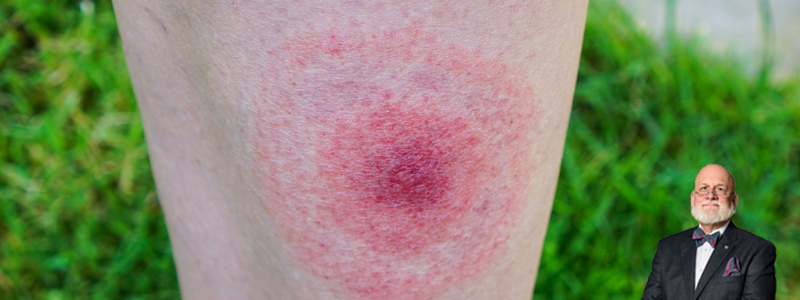Updated May, 2018 | L.J. Frieders
Ironic isn’t in? A single elevated PSA (prostate specific antigen) value and our current medical system goes into a tailspin of treatment and surgery for prostate problems – even when the traditional prostate approach is “watchful waiting”. However, a tick bite that might cause decades of misery is ignored “until that bulls-eye rash” occurs – even by people who ought to understand the serious consequences of procrastination.
Lyme disease is a bacterial infection that can develop after a bite from an infected tick. The Center for Disease Control estimates that more than 300,000 cases of Lyme disease occur annually in the U.S., with only a fraction being reported.
Many believe it’s only one type of tick that carries the disease and it’s only found in certain areas of the country – wooded or forested regions “up north”. In truth, the bacteria has been found to be transmitted by more than one carrier – and it isn’t limited to specific geographic areas – and people travel in and out of areas with ticks and carry infected bugs to other locales.
Early Lyme disease occurs within 2-30 days of a bite. Victims can develop a distinctive rash at the site of the bite, yet the classic “bull’s eye” appears in only 20% of cases. When the rash is absent, flu-like symptoms might be the only clue of the infection – and some victims have no symptoms in early disease.
Lyme Disease is caused by the bacteria, Borrelia burgdorferi, and can be treated with a number of antibiotics. Treating early – prevention – makes more sense than waiting for certain rare rashes or symptoms. How early? Right away.
Everyone who’s bitten by a tick doesn’t get Lyme disease. It’s irrational to begin aggressive antibiotic treatment – “just in case” – because the net return on high treatment costs would be tiny.
Could there be an alternative to the tedious, expensive antibiotic treatments? What if there was a way to treat every potentially infected tick bite with a small dose of topical antibiotic, applied to the site of the bite, that would halt the bacteria before it gets established in its new human home? What if it cost $100.00 and helped reduce the incidence of Lyme in two weeks – without serious side effects?
Who would benefit? For one, the thousands of people who get bitten might be spared the disease if treated early. The infection would be stopped before it started to be established. As Lyme bacteria have been associated with numerous chronic inflammatory conditions, treating every case could also help the community see fewer debilitating conditions, such as Multiple Sclerosis, Arthritis, and Psoriasis.
Who might not benefit if Lyme was prevented instead of treated? Perhaps programs that treat Lyme for the long haul – years (sometimes for life) would see a decline in their census and revenue, which often trumps true cures and improved health.Prevention would cause many people to benefit from NOT getting sick. This is not a vaccination, but an early intervention with an antibiotic treatment.
Research supports this idea. A small sample of tick bites were treated with topical antibiotic before symptoms appeared. A researcher reported “None of the test subjects went on to develop Lyme …”. While not a conclusive experiment, it suggests applying a safe topical dose of an antibiotic could effectively prevent disease. Sadly, low cost personal health pales in comparison to the profits garnered from costly long-term treatments.

